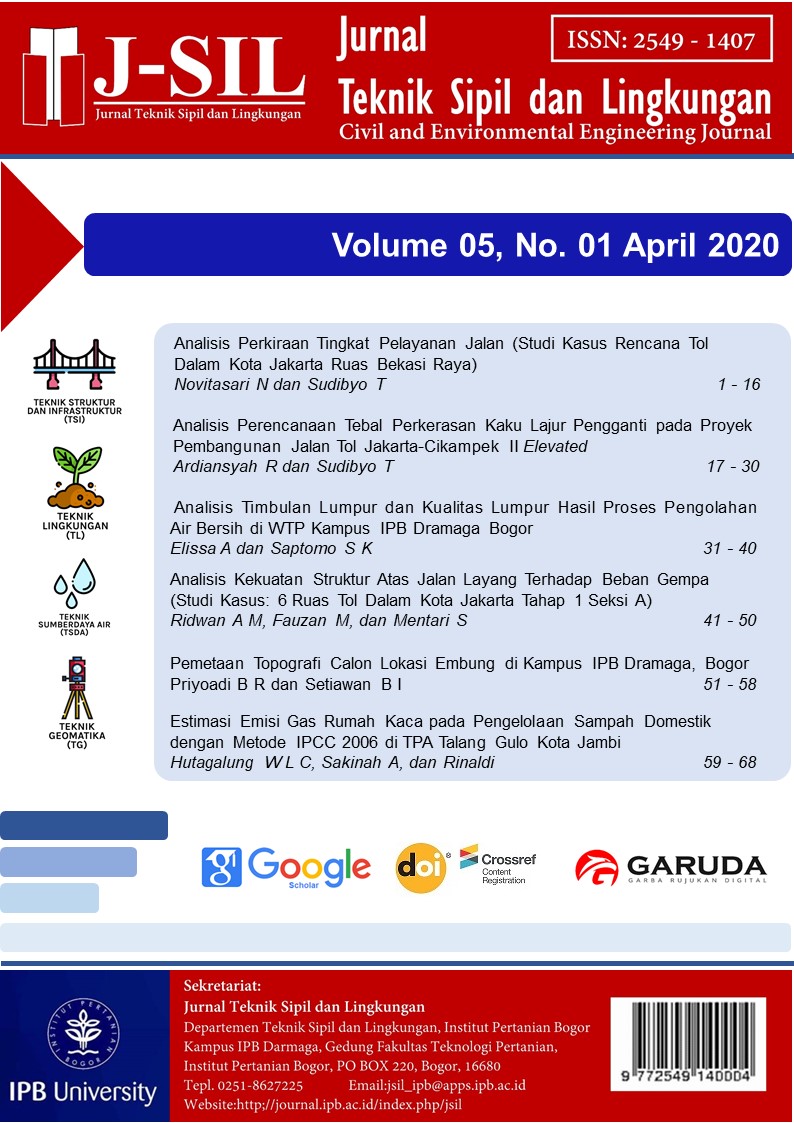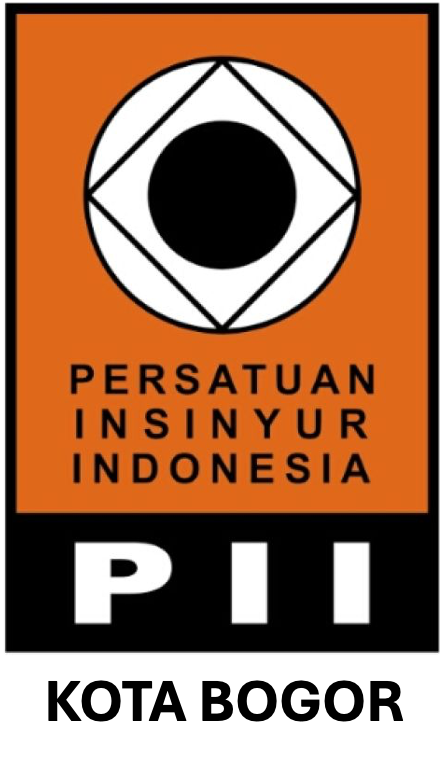Pemetaan Topografi Calon Lokasi Embung di Kampus IPB Darmaga, Bogor
Abstract
Before planning and designing a small dam, land’s topographic mapping and water flow pattern’s analysis are needed. The aim of this research were to identify the land use, water catchment areas, water flow pattern, and analyze land’s topographic condition, as well as producing topographic maps and calculating inundation volume at small dam location at IPB Campus Darmaga. This research was conducted in April - July 2019. The land use around the small dam location consisted of forests, roads, grasslands, bare land, settlements, and agriculture lands. The catchment area of the small dam location was divided into four area, with an area of 2881.0 m2, 4531.0 m2, 2790.0 m2, and 10917.3 m2 respectively. The highest and lowest elevations based on land measurements at small dam location were 199.71 masl and 187.23 masl. The topographic map was created using Surfer 13 software with the most appropriate interpolation method was natural neighbor. The direction of the surface water flow was relatively uniform and leads to the North and South. The minimum and maximum of inundation volume were 1.5 m3 and 13752.8 m3, and the optimum inundation volume was 2824.8 m3.
Downloads
References
Afifie AF. 2015. Pemetaan topografi dan rancangan perataan lahan di Balai Besar Penelitian Tanaman Padi (Subang, Jawa Barat) [skripsi]. Bogor (ID): Institut Pertanian Bogor.
Angraini L. 2018. Perencanaan desain embung di Sentul City [skripsi]. Bogor (ID): Institut Pertanian Bogor.
Aprizal. 2015. Perencanaan Embung Tejomartani Desa Branti Raya Natar, Lampung Selatan. Jurnal Teknik Sipil UBL. 6(1):696-714.
Marzuki A, Widito P, Sularto P. 2000. Pengukuran Topografi Daerah Mineralisasi Uranium Sektor Jumbang I Kalimantan Barat. Prosiding Seminar Pranata Nuklir dan Teknisi Litkayasa; Jakarta (ID): P2BGN-BATAN. hlm 43-56.
Nabilah R, Mugnisjah WQ, Gunawan A. 2017. Model lanskap permakultura Kebun Percobaan Cikabayan untuk memenuhi kebutuhan pangan bergizi mahasiswa asrama IPB. Jurnal Lanskap Indonesia. 9(1):120-126.
Purboseno S, Bambang AN, Suripin, Hadi SP. 2013. Evaluasi Karakteristik Daerah Tangkapan Air sebagai Acuan Kegiatan Konservasi Sumber Daya Air. Prosiding Seminar Nasional Pengelolaan Sumberdaya Alam dan Lingkungan; Semarang (ID): Program Studi Ilmu Lingkungan Pascasarjana Universitas Diponegoro. hlm 226-231.
Setiawan BI, Wirasembada YC, Kuswanda WP, Jannati SL, Andayani A. 2016. Penentuan Lokasi, Rancangan, dan Pembuatan Embung untuk Pertanian; Upaya Menghadirkan Solusi Permanen Mengatasi Kritis Kekeringan. Bogor (ID): Balai Besar Penelitian dan Pengembangan Sumberdaya Lahan Pertanian, Badan Penelitian dan Pengembangan Pertanian.
Siregar VP, Selamat MB. 2009. Interpolator dalam pembuatan kontur peta batimetri. E-Jurnal Ilmu dan Teknologi Kelautan Tropis. 1(1):39-47.
Ulfa A, Suprayogi S, Khoirullah EM. 2017. Perhitungan kapasitas Waduk Ngancar Batuwarno, Wonogiri, Jawa Tengah. Media Komunikasi Geografi. 18(2):156-165.
Yusniyanti E, Kurniati. 2017. Analisa puncak banjir dengan metode MAF (studi kasus Sungai Krueng Keureuto). Jurnal Einstein. 5(1):7-12.
Copyright (c) 2020 Jurnal Teknik Sipil dan Lingkungan

This work is licensed under a Creative Commons Attribution-NonCommercial-NoDerivatives 4.0 International License.
Authors who publish with Jurnal Teknik Sipil dan Lingkungan, JSIL agree to the following terms:
a. Authors retain copyright and grant the journal right of first publication with the work simultaneously licensed under a Creative Commons Attribution License that allows others to share the work with an acknowledgment of the work's authorship and initial publication in this journal.
b. Authors are able to enter into separate, additional contractual arrangements for the non-exclusive distribution of the journal's published version of the work (e.g., post it to an institutional repository or publish it in a book), with an acknowledgment of its initial publication in this journal.
c. Authors are permitted and encouraged to post their work online (e.g., in institutional repositories or on their website) prior to and during the submission process, as it can lead to productive exchanges, as well as earlier and greater citation of published work (See The Effect of Open Access).











